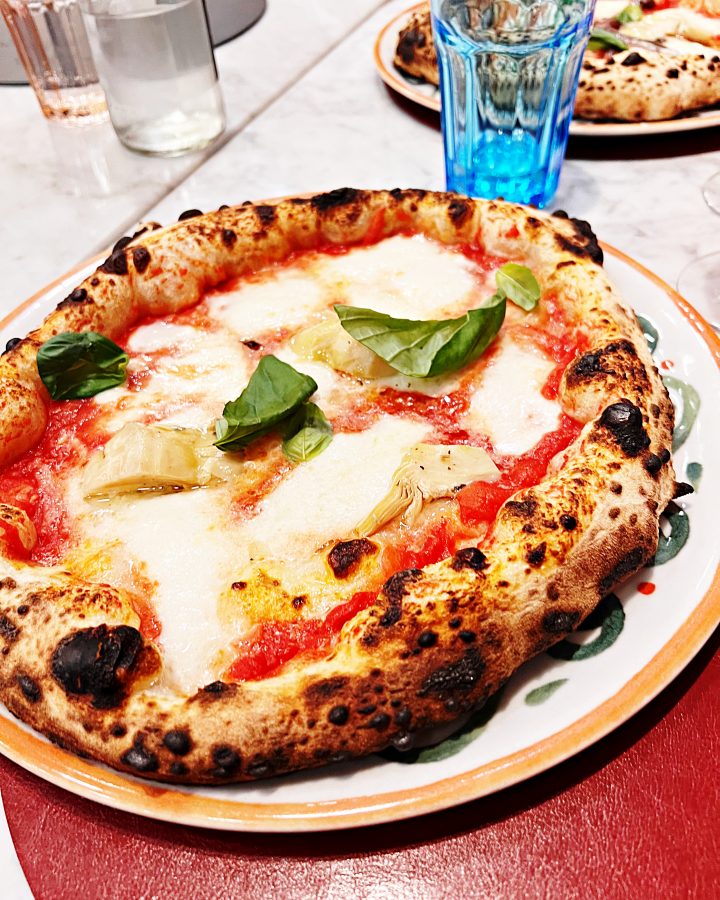- rapido pizza
- Gaetano Adamo
Naples is known for a particular style of pizza, thick around the rim and floppy in the centre. There is even a special method of eating it, where you fold a quarter in half lengthways so that the filling doesn’t fall out, a skill in itself. Neapolitan pizza has been declared an ‘intangible cultural heritage of humanity’ by UNESCO.
London-based Neapolitan pizza has been in the news recently: Napoli On the Road, based in Chiswick, won the award for best pizza in the world at the World 50 Top Pizza Awards where judges claimed: ‘you can savor the authentic flavors of Neapolitan pizza with a contemporary twist. Featuring long-fermented dough, a pronounced crust, top-quality ingredients, melt-in-your-mouth texture, and very high digestibility’
In London we have other Neapolitan imports: a couple of branches of l’Antica Pizzeria Da Michele in Stoke Newington and Baker Street, and near me in Kilburn, ‘Quartieri’ a branch of a Naples pizzeria Trianon.
In Naples itself, tourists queue for up to two hours to try the Neapolitan pizza at L’Antica Pizzeria da Michele, going since 1870, made globally famous by its appearance in the novel and film ‘Eat, Pray, Love’. The menu is exquisitely simple, always a good sign. There are only three types of pizza: the Margherita with tomatoes, basil and fior di latte cheese; the Marinara, with tomatoes, garlic and oregano but no cheese; and the Cosacca, with basil, tomato, pecorino cheese
I have not yet tried the other most famous Neapolitan pizzeria, Gino Sorbillo Antica Pizzeria which was established in 1935. They have a larger variety of pies (is it a pie? Americans think so) which doesn’t appeal so much to the purist in me.
But the last few times I’ve visited Naples I’ve been eating the food of Gaetano Adamo, a 26 year old up and coming pizzaiolo. He runs an eponymously titled local restaurant, Gaetano Adamo near to the bed and breakfast where I always stay. This place was set up by his dad (now retired at a mere 51 years old) as a traditional restaurant, without the pizza oven.
One evening, I sit with Gaetano on the little table he has next to the oven. He’s married with a four year old son and covered in Japanese tattoos, an ongoing project. ‘I have full sleeves and all my back, but my legs are empty’ he lamented.
Why pizza?
‘I’ve been obsessed with it since I was 19. I’m not in it for the money, I’m in it for the art, the sheer skill. I spent weeks, months, years, testing out different recipes, researching ingredients.’
Tell me about the ingredients.
‘My tomatoes come from a little local village – I go and negotiate every year to make sure I have enough of this type.’
‘I use Molino Vigevano flour, it’s a mill in the north of Italy. I think it’s the best. Most pizzerias use Caputo flour – I prefer this one.’
I look at his mise en place set out on the counter: the usual stuff: parmesan, tomatoes, cheese, basil, capers but also a tub of black stuff.
“This is olive dust. I put the black olives in the oven and dehydrate them, then grind them. It’s wonderful”
He makes me a pizza, patting and shoving a disk of dough, smeared with tomato sauce and scattered with buffalo mozzarella, into the domed red mosaic pizza oven. A minute later the peel is removed, revealing a puffy, charred, smoking pizza.
‘There are two types of pizza in Naples–a thin crust and a rapido. This is a rapido. It only takes between 60 and 90 seconds to cook.’ gestures Gaetano.
‘You want I cut it?’
I nod.
‘Traditionally you cut it into four pieces, not more. Thsi way you keep the structure’ He lifts the crust of the pizza to show me in more detail the billowing edge of the dough – it has airy holes like sourdough.
I take a quarter, fold it in half from the outer edge radiating to the centre. The cheese slides off, so I scoop it back on.
I love the tomatoes, they taste slightly uncooked, fruity yet with a metallic acidity. The cheese is milky. In the centre of the pizza there is tomato, cheese liquid with a little basil. I use torn off bits off the crust to mop it up.
Is it hard work? Especially in the summer when it hits 40C?
He shrugs “It’s the work, it’s the job”.
What is your favourite pizzeria in Naples, aside from your own of course?
“50 Kalo. Kalo is dialect for good. 50 means bread.” 50 Kalo also has a branch in London.
So the name means good bread?
‘Yes! The pizzaiolo of 50 Kalo, Ciri Salvo, also uses great ingredients.’
What do you think about pineapple on pizza?
He laughs. ‘I’m from Naples, we don’t do this. But Sorbillo, he is doing it, putting pineapple on pizza.’
I note Daniel Young’s ‘Where to Eat Pizza’ compendium of pizza in pride of place on his bookshelf.
‘I love this guy. My ambition is to be in his book. He came here you know but unfortunately I was away. Every year I go away, to eat, to be inspired. I went to Thailand, Dubai, Malaysia, Australia. I take my wife and son. I want to go to Japan. I trained a Japanese pizzaiolo, he worked here for a year and now has his own place in Japan.’
‘But my ultimate ambition is to start a pizzeria in London.’






We are at Gaetanos’ restaurant twice whilst staying in Naples. It was recommended by our host and did not disappoint!
My husband informed me “ The best pizza I’ve ever eaten “ and he’s eaten a lot of pizza !!!
The atmosphere in the restaurant is authentic Italian and the staff busy, friendly and patient. I observed it’s a place many Italians like to eat! Highly recommended.
It’s a great restaurant isn’t it?